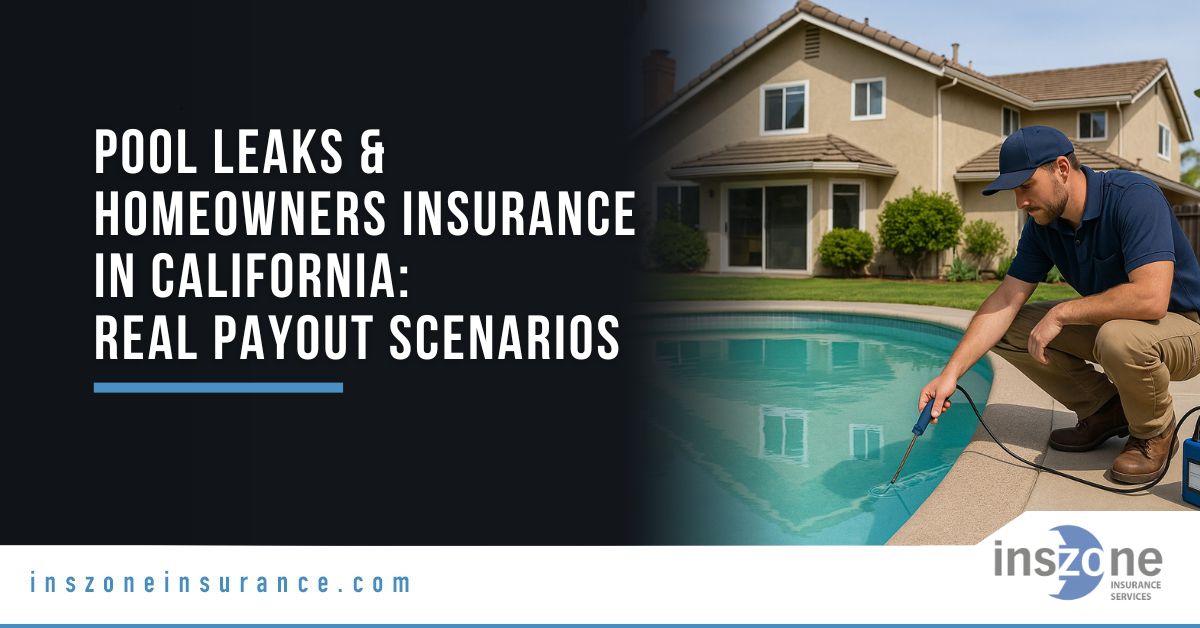Pool leaks can be sneaky, expensive, and—depending on the cause—sometimes not covered by insurance. This guide explains when California homeowners insurance helps, how deductibles and endorsements work, where the California FAIR Plan (and a DIC “wrap”) fits in, and what to do if you suspect a leak. We include real-world payout math, a simple claims checklist, and FAQs.
Table of Contents
- What types of pool leaks are covered?
- How California policies treat water damage in 2025
- Real-world scenarios & likely outcomes
- Coverage stack in California: HO-3 vs. FAIR Plan + DIC
- Which endorsements actually help with pool leaks?
- How to file: a quick claims checklist
- Payout math: simple examples
- Prevention & documentation that save claims
- Why this matters for the insurance industry in 2025
- Frequently asked questions
- Sources and Further Reading
What Types of Pool Leaks Are Covered?
California homeowners policies generally cover water damage that is sudden and accidental (for example, a burst supply line) but exclude gradual, maintenance-related problems such as slow seepage, worn liners, or long-term deterioration.
How California Policies Treat Water Damage in 2025
Covered: sudden discharge from plumbing or appliances, with resulting damage to walls, floors, and belongings. Policies usually do not pay to repair the failed part itself unless another covered peril caused the break.
Excluded: floods, groundwater, earth movement, and continuous or repeated seepage or leaks. These exclusions are emphasized by the California Department of Insurance consumer guide.
Real-World Scenarios & Likely Outcomes
Scenario 1: Broken Underground Pipe
What happened: A buried supply line beneath the deck suddenly fails, releasing thousands of gallons and affecting nearby structures.
Outcome: Resulting water damage is typically covered as “sudden and accidental.” Repair of the failed line itself is usually not covered unless you purchased a service line endorsement.
Scenario 2: Gradual Liner Leak
What happened: A vinyl liner slowly seeps for months, causing soil erosion and property damage.
Outcome: Generally denied as wear-and-tear or maintenance. The homeowner pays for repairs out of pocket.
Scenario 3: Wildfire Debris & Heat Crack the Pool
What happened: Debris and extreme heat from a nearby wildfire crack the pool, leading to sudden water loss.
Outcome: Covered under a standard homeowners policy as part of the wildfire claim. FAIR Plan alone would not cover ensuing water damage; a DIC (Difference-in-Conditions) policy is required for full protection.
Coverage Stack in California: HO-3 vs. FAIR Plan + DIC
Private HO-3 policy: Broad “all-risk” protection (except listed exclusions). Sudden and accidental water damage is typically covered.
FAIR Plan: Fire-centric coverage for those who cannot secure private insurance. Water damage is not included.
DIC wrap: Sold alongside FAIR Plan policies to add coverage for water damage, theft, liability, and more. Essential for full protection.
Which Endorsements Actually Help with Pool Leaks?
- Service line coverage: Helps pay for the failed underground line itself, often with limits of $10,000–$25,000.
- Water backup/sump overflow: Adds protection if water backs up through drains or sumps.
- Equipment breakdown: Covers certain sudden failures of home systems; may extend to pool equipment depending on policy.
- Earthquake insurance: Needed separately since standard homeowners policies exclude earth movement.
How to File: A Quick Claims Checklist
- Stop the leak and document damage with photos or video.
- Notify your insurance company promptly.
- Hire professional leak detection and save invoices.
- Keep damaged parts for inspection.
- Ask your adjuster to clarify covered damage, tear-out, and endorsements.
Payout Math: Simple Examples
| Scenario | Damage | Deductible | Endorsement | Estimated Insurer Payment |
|---|---|---|---|---|
| Underground pipe burst | $40,000 | $2,500 | Service line ($10k) | $22,500 |
| Slow liner leak | $8,000 | N/A | None | $0 (excluded) |
| Wildfire debris crack | $75,000 | $5,000 | FAIR Plan + DIC | $70,000 |
Prevention & Documentation That Save Claims
- Install water-use monitors to detect spikes.
- Schedule annual leak checks and pressure tests.
- Keep photos of equipment serial numbers and maintenance logs.
- Maintain defensible space and fire-resistant features to reduce wildfire risks.
Why This Matters for the Insurance Industry in 2025
California’s property insurance market is under stress due to wildfire losses and reinsurance costs. FAIR Plan enrollment exceeded 600,000 policies in 2025, highlighting market displacement. Insurers are stricter about water-damage claims, especially pool-related losses, and often deny maintenance-based claims to stabilize premiums.
Frequently Asked Questions
Does insurance cover the cost to refill the pool after a leak?
No. Replacing lost water is not covered.
Are pump or filter failures covered?
Only the sudden resulting damage is covered. Replacing the failed equipment is usually excluded unless equipment breakdown coverage applies.
Will filing a pool leak claim raise my premiums?
Yes. Water claims are considered high-risk in California and often lead to premium increases or non-renewal.
Can I buy special pool insurance?
No single pool policy exists, but endorsements such as service line coverage and DIC wraps expand protection.
What about earthquake cracks?
Standard policies exclude earth movement; earthquake insurance is needed separately.
Sources and Further Reading
- California Department of Insurance — FAIR Plan overview
- California FAIR Plan — Key Statistics & Data (2025)
- CDI Consumer Guide — Homeowners Insurance
- Insurance Information Institute — Homeowners Basics
- California FAIR Plan — DIC Policy Explanation
- Progressive — Service Line Coverage
- Erie Insurance — Service Line Limits
- NAIC — Consumer Earthquake Guide
- Bankrate — Premiums After a Claim
- AP News — FAIR Plan wildfire funding (2025)
This article is for educational purposes only and does not replace personalized advice from a licensed insurance agent.





